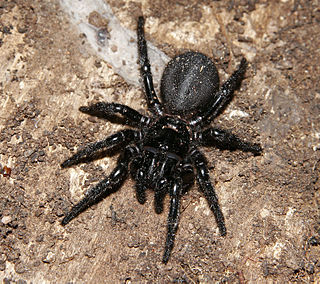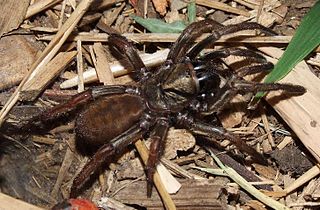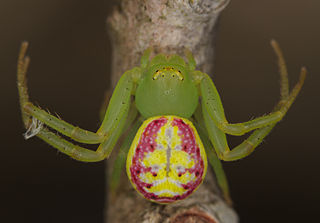
The genus Argiope includes rather large spiders that often have a strikingly coloured abdomen. These spiders are distributed throughout the world. Most countries in tropical or temperate climates host one or more species that are similar in appearance. The etymology of Argiope is from a Latin word argentum meaning silver. The carapace of Argiope species is typically covered in silvery hairs.

Huntsman spiders, members of the family Sparassidae, are known by this name because of their speed and mode of hunting. They are also called giant crab spiders because of their size and appearance. Larger species sometimes are referred to as wood spiders, because of their preference for woody places. In southern Africa the genus Palystes are known as rain spiders or lizard-eating spiders. Commonly they are confused with baboon spiders from the Mygalomorphae infraorder, which are not closely related.

Lynx spider (Oxyopidae) is a family of araneomorph spiders first described by Tamerlan Thorell in 1870. Most species make little use of webs, instead spending their lives as hunting spiders on plants. Many species frequent flowers in particular, ambushing pollinators, much as crab spiders do. They tend to tolerate members of their own species more than most spiders do, and at least one species has been identified as exhibiting social behaviour.

Ground spiders comprise Gnaphosidae, the seventh largest spider family with nearly 2,000 described species in over 100 genera distributed worldwide. There are 105 species known to central Europe, and common genera include Gnaphosa, Drassodes, Micaria, Cesonia, Zelotes and many others. They are closely related to Clubionidae. At present, no ground spiders are known to be seriously venomous to humans.

Ant spiders are members of the family Zodariidae. They are small to medium-sized eight-eyed spiders found in all tropical and subtropical regions of South America, Africa, Madagascar, Australia-New Guinea, New Zealand, Arabia and the Indian subcontinent. Most species are daytime hunters and live together with ants, mimicking their behavior and sometimes even their chemical traits. Although little is known about most zodariids, members of the genus Zodarion apparently feed only on ants; a number of other genera in the family are apparently also ant specialists.

Hadronyche is a genus of venomous Australian funnel-web spiders that was first described by L. Koch in 1873. Originally placed with the curtain web spiders, it was moved to the Hexathelidae in 1980, then to the Australian funnel-web spiders in 2018.

Missulena is a genus of mygalomorph spiders in the family Actinopodidae, sometimes called mouse spiders. It was first described by Charles Athanase Walckenaer in 1805. M. tussulena is found in Chile, but the rest are indigenous to Australia.

Trite is a genus of jumping spiders first described by Eugène Simon in 1885. Most of the 18 described species occur in Australia and New Zealand, with several spread over islands of Oceania, one species even reaching Rapa in French Polynesia.

Zenodorus is a genus of the jumping spiders distributed from the Moluccas to Australia, including several islands of the Pacific. It was once considered a junior synonym of Omoedus, but this was later rejected by Jerzy Prószyński in 2017. At least one species, Z. orbiculatus, specializes on hunting ants.

Idiopidae, also known as armored trapdoor spiders, is a family of mygalomorph spiders first described by Eugène Simon in 1889. They have a large body similar to tarantulas.

Prodidominae is a spider subfamily, sometimes called long-spinneret ground spiders. It was formerly regarded as a separate family, Prodidomidae, which was reduced to a subfamily of the Gnaphosidae in 2018.

Badumna is a genus of intertidal spiders that was first described by Tamerlan Thorell in 1890. They are harmless spiders that can be found around human structures and buildings. They are darkly colored, usually with a lighter colored pattern on the abdomen. The most well-known species is B. insignis, also known as the "black house spider" or "black window spider".

William Joseph Rainbow (1856–1919) was an entomologist and arachnologist whose work includes the first catalogue of Australian spiders.

Arbanitis is a genus of Australian armored trapdoor spiders that was first described by Ludwig Carl Christian Koch in 1874.
Cataxia is a genus of Australian armored trapdoor spiders that was first described by William Joseph Rainbow in 1914.
Euoplos is a genus of Australian armored trapdoor spiders that was first described by William Joseph Rainbow in 1914.

Arkyidae is a family of araneomorph spiders first described by Ludwig Carl Christian Koch in 1872 as a subfamily of Araneidae, and later elevated to a full family in 2017.

Dolophones is a genus of orb-weaver spiders first described by Charles Athanase Walckenaer in 1837.
Cryptoerithus is a genus of Australian ground spiders that was first described by William Joseph Rainbow in 1915. Originally placed with the long-spinneret ground spiders, it was transferred to the ground spiders in 2018.

Tharrhalea is a genus of crab spiders first described in 1875 by Ludwig Carl Christian Koch.
















